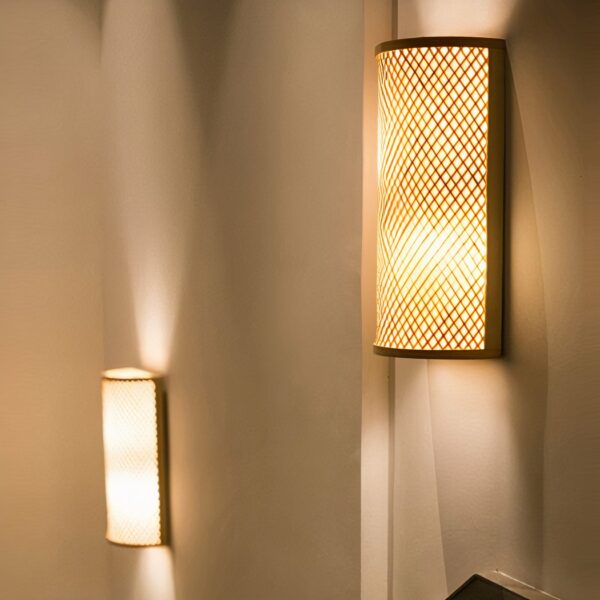Showing the single result
Showing the single result
The Art of Japanese Lighting
Minimalist, uncluttered design
At the heart of Japanese lighting art lies the quest for simplicity. Japanese wall sconces embody this minimalist aesthetic, where every curve and line plays a decisive role in shaping the mood of a room. They offer much more than light; they sculpt space, bringing a tranquility and clarity that aligns with the Zen principles of order and natural beauty.
The symbolism of shapes in lighting
In Japanese tradition, every shape holds a symbolism, a story to tell. Wall sconces draw on this rich heritage, adopting silhouettes that evoke the softness of the moon or the immensity of landscapes. These luminous creations reflect Japan’s natural landscapes, inviting the serenity of nature into the home, transforming every wall into a poetic scene of light and shadow.
Materials and Manufacturing
The choice of traditional materials
The Japanese wall light collection is deeply inspired by natural resources, favoring authentic materials that have shaped the craftsmanship of the land of the rising sun. Wood, from sustainably managed forests, brings warmth and solidity. Washi paper, translucent and resistant, diffusing a soft, soothing light, is skilfully employed. Precision-worked metal adds a contemporary touch without distorting the traditional look. These carefully chosen materials are not simply components; they are the heart of an artistic heritage perpetuated through each sconce.
Precision Japanese manufacturing
The manufacture of a Japanese wall sconce is a celebration of the expertise and meticulous attention of craftsmen. Using techniques handed down from generation to generation, these craftsmen achieve a level of precision that guarantees not only the authenticity of each piece, but also its durability. Every chisel, every bend, every weld is carried out with a care that ensures each wall sconce is not only a lighting product, but a work of art in itself.
Harmonizing with the Living Space
Selection according to space
Finding the right Japanese wall sconce requires careful attention to the size and structure of the room. A half-moon model might, for example, fit perfectly in a narrow corridor, projecting warm, indirect light, while a larger, open format would be ideal for spacious living rooms, offering more diffused, encompassing illumination. It’s essential to consider ceiling height, wall width, and furniture arrangement to ensure that the sconce fits in harmoniously, while fulfilling its primary function: to illuminate optimally.
Lighting’s influence on well-being
Lighting plays a crucial role in creating an environment conducive to well-being. Japanese wall lights, with their soft, natural light, can transform the atmosphere of an interior, inviting relaxation and serenity. The choice of a fabric or washi paper shade lets in a subdued light that promotes a state of calm and concentration. In fact, the brightness and color of light directly influence mood and visual comfort, making Japanese wall sconces more than just an aesthetic choice, but a true vector of well-being in the home.
Answers to Frequently Asked Questions about Japanese Wall Sconces
FAQ – Japanese Wall Light
Q1: What type of bulb is recommended for a Japanese Wall Lamp
Answer:Japanese Wall Lights are often designed for LED bulbs due to their energy efficiency and longevity. It’s important to check the specifications of each sconce to choose the appropriate bulb type and wattage, especially if the sconce uses delicate materials such as paper or silk.
Q2: How to install a Japanese wall light correctly
Answer:The installation of Japanese Wall Sconces often requires fixing the base of the sconce to the wall, then connecting the electrical wires. Given the delicate nature of some of the materials used, it’s advisable to carefully follow the instructions provided, or call in a professional for a safe installation.
Q3: How do I maintain my Japanese wall light?
Answer:To maintain, gently dust the sconce with a soft cloth or feather duster. If the sconce has paper or silk parts, be especially gentle to avoid tearing or staining them. Avoid using damp or chemical cleaning products.
Q4: Where is it best to place a Japanese Wall light ?
Answer: Choose a location where the sconce can add a decorative touch while providing ambient lighting. Japanese Wall Sconces are ideal in bedrooms, living rooms or hallways, bringing a touch of tranquility and aesthetic minimalism.
Q5: Are Japanese Wall Lights suitable for different interior styles?
Answer:Yes, their clean, minimalist design means that Japanese Wall Lights can easily blend in with a variety of decors, although they are particularly suited to interiors inspired by Zen or Asian styles.
Q6: Is it possible to adjust the light intensity of Japanese Wall Lights?
Answer:It depends on the specific model of wall light. Some models can be equipped with a dimmer switch to adjust light intensity. Check the product specifications for this feature.
Conclusion
The Japanese Wall light in our collection, with their refined, peaceful aesthetic, offer a unique way to illuminate and decorate your space. By combining these sconces with Modern Wall Lights with the Japanese Style Wicker Wall Sconces, you can create a harmonious blend of styles that enriches your interior decor. The modern wall lamp, with their sleek, contemporary design, can perfectly complement the simple lines and luminous softness of the japanese wall lights bringing a touch of modernity while respecting the Zen aesthetic.
On the other hand, “Japanese Style Wicker Wall Lights” add natural texture and organic warmth, reinforcing the serene mood and connection to nature that Japanese wall lights seek to evoke. By integrating these different styles of wall sconces into your interior, you create a space that is not only functionally lit, but also enriched by a variety of shapes, materials and designs. Whether you’re looking to create a quiet corner in your home or add understated elegance to your living space, the combination of these wall sconces can transform any room into a place of relaxation, beauty and harmony.
